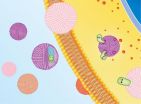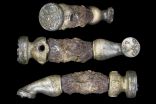(Press-News.org) The mutations were familiar, but the patients' conditions seemed baffling at first. A team lead by Rockefeller University researchers had linked variations in an immune gene to rare bacterial infections. Shortly afterward, Chinese scientists told them of three children in that country with mutated versions of the same gene. However, the Chinese children had no history of the severe bacterial infections. Instead, they had seizures and unusual calcium deposits deep in their brains.
This discrepancy led to the discovery of an immune protein with paradoxical roles: It both aids and tamps down aspects of an immune system response, according to research conducted in Jean-Laurent Casanova's St. Giles Laboratory of Human Genetics of Infectious Diseases at Rockefeller in collaboration with scientists in China and elsewhere. The team's report was published Sunday, October 12, in Nature.
"It has turned out that mutations in a single gene eliminate the immune protein ISG15, giving rise to two different problems: an inability to resolve harmful inflammation, which can lead to autoimmune disease, and susceptibility to infections caused by the tuberculosis bacterium and its cousins," Casanova says. "By identifying the source of this genetic disorder, we have taken a first step toward finding treatments for those facing the autoimmune disease and severe TB-related infections it may produce."
When under attack, the immune system releases signaling proteins known as interferons, which further activate the body's defenses. In previous research, Dusan Bogunovic, a former postdoc in the lab now an Assistant Professor at the Department of Microbiology at Icahn School of Medicine at Mount Sinai, linked a lack of ISG15 to an unusual vulnerability to infections by mycobacteria, a group of common bacteria that include the TB bug. He and colleagues found three children, one from Turkey, two from Iran, who became severely ill after receiving the anti-tuberculosis BCG vaccine. Normally, ISG15 protects against infection by mycobacteria by prompting the release of type 2 interferon, but all three children had two copies of a defective form of the ISG15 gene, and became infected by a TB-related component of the vaccine.
After this discovery, ISG15's story continued to unfold. Bogunovic and his colleagues reported this link, and then scientists in China reached out saying they had also seen loss-of-function mutations in three patients, all from a single family. But none of these three had had unexplained mycobacterial infections, such as those caused by the vaccine.
"We asked, why were they patients?" Bogunovic recalls. "Our Chinese colleagues said these kids had seizures; in fact, one child had died from them. When we looked into their BCG vaccination history, we found these children, who were born at home in a remote village, never received their shots, so they never became sick. Next we looked back at our first set of patients. None of them had ever had seizures, but we performed brain scans that found abnormal calcium deposits in a deep part of the brain involved in controlling movement — just like the deposits in brains of the Chinese children."
The researchers recognized the calcium deposits as a feature of a group of autoinflammatory diseases, including the neurodevelopmental disorder Aicardi-Goutieres syndrome. These are thought to occur when type 1 interferon, which normally helps fight viral infections, runs amok, triggering harmful and unnecessary inflammation, leading to disease. When Bogunovic and his colleagues then looked for evidence something similar was happening to the six patients, they found unusually high expression of genes stimulated by type 1 interferon.
Using cells from the patients, the researchers found that when they restored the ISG15 gene, the cells became able to resolve the inflammation. Further experiments performed in collaboration with Sandra Pellegrini at the Pasteur Institute in Paris, France, revealed the mechanics that linked a lack of ISG15 with an increase in type 1 interferon signaling: Under normal conditions, ISG15 prevents the degradation of another protein, USP18, which is responsible for turning down the dial on type 1 interferon. With no ISG15, and as a result, little USP18, interferon becomes too active.
The six children all showed elevated levels of autoantibodies, immune proteins that mistakenly attack the body itself, suggesting that in time they will likely develop autoimmune disease. "However, with this knowledge, we hope they can monitor and properly treat this condition, just as they know now to avoid the BCG vaccine and other possible sources of mycobacterial infection," Bogunovic says. "Ultimately, ISG15 deficits may be included in genetic screening tests for infants to make early detection widely available. No treatments exist for many autoimmune disorders, but our work advances our understanding of them, and, as a result, the prospects for finding cures."
INFORMATION:
High-resolution cryo-electron microscopy has now revealed in unprecedented detail the structural changes in the bacterial ribosome which results in resistance to the antibiotic erythromycin.
Multiresistant bacterial pathogens that are insensitive to virtually all available antibiotics are one of the major public-health challenges of our time. The question of how resistance to various antibiotics develops is the focus of research being carried out by Ludwig-Maximilians-Universitaet (LMU) in Munich biochemist Daniel Wilson and his colleagues. As they report in the journal ...
Scientists from Queen Mary University of London (QMUL) and UCL (University College London) have identified what they believe could be a cause of pre-term premature rupture of the fetal membrane (PPROM), which accounts for 40 per cent of pre-term births, and is the main reason for infant death world-wide.
The researchers, whose work was funded by the charity Wellbeing of Women, used bioengineering techniques to test the effect of repetitive stretch on tissues of the amniotic membrane which surrounds and protects the baby prior to birth.
They found that stretching of the ...
New York | Heidelberg, 13 October 2014 Increasing reliance on renewable energies is the way to achieve greater CO2 emission sustainability and energy independence. As such energies are yet only available intermittently and energy cannot be stored easily, most countries aim to combine several energy sources. In a new study in EPJ Plus, French scientists have come up with an open source simulation method to calculate the actual cost of relying on a combination of electricity sources. Bernard Bonin from the Atomic Energy Research Centre CEA Saclay, France, and colleagues demonstrate ...
Scientists from Nanyang Technological University (NTU Singapore) have developed a new battery that can be recharged up to 70 per cent in only 2 minutes. The battery will also have a longer lifespan of over 20 years.
Expected to be the next big thing in battery technology, this breakthrough has a wide-ranging impact on many industries, especially for electric vehicles which are currently inhibited by long recharge times of over 4 hours and the limited lifespan of batteries.
This next generation of lithium-ion batteries will enable electric vehicles to charge 20 times ...
In the context of an aging population, the number of cases of people with multimorbidity, or multiple health conditions, is increasing, creating significant healthcare challenges. Now, the first comprehensive systematic review in this field has found higher levels of multimorbidity in women. Equally as importantly, it has revealed the poor quality of evidence on this increasingly critical area of healthcare.
The review's main author, Professor Jose M Valderas, NIHR Clinician Scientist of the University of Exeter Medical School, is calling for better quality research to ...
Biomedical engineering researchers have developed a drug delivery system consisting of nanoscale "cocoons" made of DNA that target cancer cells and trick the cells into absorbing the cocoon before unleashing anticancer drugs. The work was done by researchers at North Carolina State University and the University of North Carolina at Chapel Hill.
"This drug delivery system is DNA-based, which means it is biocompatible and less toxic to patients than systems that use synthetic materials," says Dr. Zhen Gu, senior author of a paper on the work and an assistant professor in ...
Scientists at the Luxembourg Centre for Systems Biomedicine (LCSB) of the University of Luxembourg have published their findings that mutations in a gene known as "ARMC5" promote the growth of benign tumours in the adrenal glands and on the meninges: ARMC5 appears to belong to the group of so-called tumour suppressor genes. It is the first time in years that scientists have characterized such a gene.
The ARMC5 gene was discovered by independent workgroups studying benign tumours – so-called adrenal adenomas – in connection with Cushing's syndrome. In this ...
University of Leicester archaeologists have made a "once-in-a-career" discovery of the decorated bronze remains of an Iron Age chariot.
A team from the University's School of Archaeology and Ancient History has unearthed a hoard of rare bronze fittings from a 2nd or 3rd century BC chariot which appears to have been buried as a religious offering.
The archaeologists found the remains during their ongoing excavation of the Burrough Hill Iron Age hillfort, near Melton Mowbray, Leicestershire.
The School has led a 5-year project there since 2010, giving archaeology students ...
Parkinson's disease is strongly linked to the degeneration of the brain's movement center. In the last decade, the question of where the disease begins has led researchers to a different part of the human anatomy. In 2003, the German neuropathologist Heiko Braak presented a theory suggesting that the disease begins in the gut and spreads to the brain. The idea has since, despite vocal critics, gained a lot of ground. Researchers at Lund University in Sweden now present the first direct evidence that the disease can actually migrate from the gut to the brain.
The so-called ...
Chemists at Ludwig-Maximilias-Universitaet (LMU) in Munich have synthesized a ferromagnetic superconducting compound that is amenable to chemical modification, opening the route to detailed studies of this rare combination of physical properties.
Superconductivity and ferromagnetism – the "normal" form of magnetism, such as that found in the familiar horseshoe magnet – are like chalk and cheese: They generally don't go together. Ferromagnets are magnetic because the parallel alignment of adjacent electron spins in the iron atoms generates a strong internal ...



